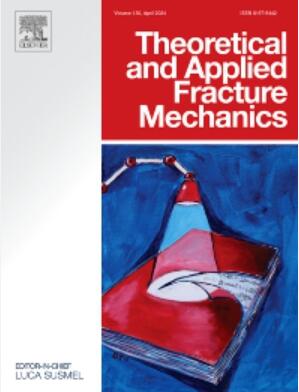Study on the I-II mixed mode fatigue crack growth behavior of TC4 titanium alloy
IF 5.6
2区 工程技术
Q1 ENGINEERING, MECHANICAL
引用次数: 0
Abstract
This article focuses on investigating the influence of mixed mode loading and loading ratio on the fatigue crack growth (FCG) behaviors of TC4 titanium alloy. It reveals that there exists a transformation towards mode I dominant crack for mixed mode crack, while the existing mode II component at crack tip still has effects on FCG behavior, which causes a continuous change in the crack propagation path and a slower fatigue crack growth rate. During the crack propagation, the non-collinear loading has an important role on the stress intensity factor, which causes greater mode I and mode II stress intensity factors. The improved expressions of SIFs have been proposed taken the non-collinear loading into account. The effects of mixed mode loading and loading ratio on the crack tip fields were also discussed, where the SIF acting as the driving force was modified to be applicable to all the loading ratios. The FCGR curve with relationship of the equivalent SIF was proposed taking the compressive loading and mixed mode loading into consideration.
TC4钛合金I-II混合模态疲劳裂纹扩展行为研究
本文重点研究了混合模式加载和加载比对TC4钛合金疲劳裂纹扩展行为的影响。结果表明,混合模态裂纹存在向I型主导裂纹的转变,而裂纹尖端存在的II型成分对FCG行为仍有影响,导致裂纹扩展路径持续变化,疲劳裂纹扩展速率变慢。在裂纹扩展过程中,非共线加载对应力强度因子有重要影响,导致ⅰ型和ⅱ型应力强度因子较大。在考虑非共线载荷的情况下,提出了SIFs的改进表达式。讨论了混合模态加载和加载比对裂纹尖端场的影响,修改了SIF作为驱动力,使其适用于所有加载比。在考虑压缩载荷和混合模态载荷的情况下,提出了具有等效SIF关系的FCGR曲线。
本文章由计算机程序翻译,如有差异,请以英文原文为准。
求助全文
约1分钟内获得全文
求助全文
来源期刊

Theoretical and Applied Fracture Mechanics
工程技术-工程:机械
CiteScore
8.40
自引率
18.90%
发文量
435
审稿时长
37 days
期刊介绍:
Theoretical and Applied Fracture Mechanics'' aims & scopes have been re-designed to cover both the theoretical, applied, and numerical aspects associated with those cracking related phenomena taking place, at a micro-, meso-, and macroscopic level, in materials/components/structures of any kind.
The journal aims to cover the cracking/mechanical behaviour of materials/components/structures in those situations involving both time-independent and time-dependent system of external forces/moments (such as, for instance, quasi-static, impulsive, impact, blasting, creep, contact, and fatigue loading). Since, under the above circumstances, the mechanical behaviour of cracked materials/components/structures is also affected by the environmental conditions, the journal would consider also those theoretical/experimental research works investigating the effect of external variables such as, for instance, the effect of corrosive environments as well as of high/low-temperature.
 求助内容:
求助内容: 应助结果提醒方式:
应助结果提醒方式:


